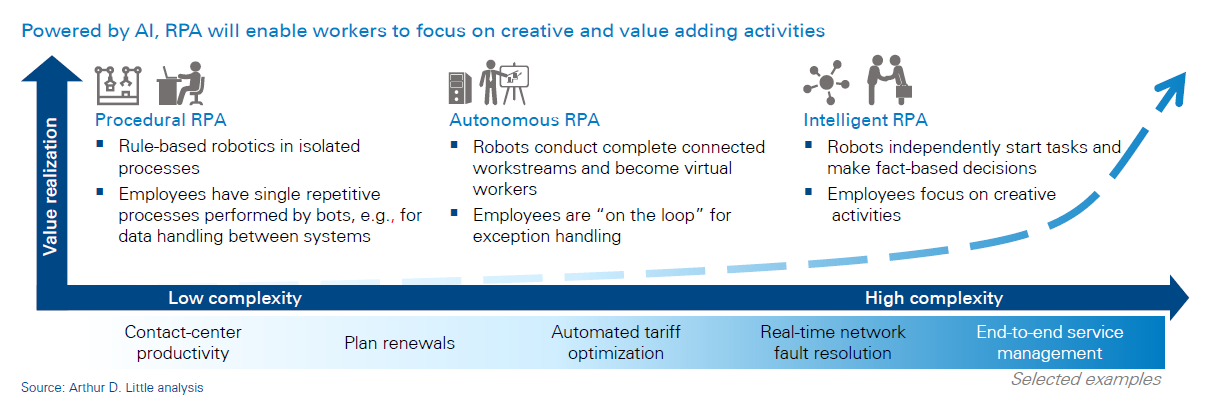
DOWNLOAD
DATE
Contact
Robotic process automation (RPA) and artificial intelligence (AI) are complementary – when implemented together they enlarge the scale of value that can be created. AI can add intelligence to automated processes, enabling companies to extract insight on which they can base data-driven business decisions. AI capabilities can also enhance automation in which RPA falls short, as it can be used to digitize and structure data, which RPA systems subsequently act upon. AI-powered RPA offers powerful opportunities and will affect communication service providers (CSPs) in the near future. Arthur D. Little has identified three major areas where AI together with RPA has the most potential to realize value for CSPs – operational efficiency, commercial analytics, and threat management. In this viewpoint we give practical insight into how CSPs can embark on the AI-powered RPA opportunity.
AI will tilt the RPA value scale for CSPs
Since the late 1950s, artificial intelligence (AI) has been a topic of varying relevance for businesses in all industries. Throughout the history of AI, there have been many examples of services and businesses claiming to use it, but often these have failed to live up to the hype. However, during the last 10 years, the technologies underpinning AI capabilities have dramatically improved. The funding activities of AI have increased steadily, with a CAGR exceeding 50 percent, since 2009. New algorithms, capable hardware, and increased interest from businesses and academia have provided the foundation for AI solutions that can offer actionable insight, predictions, and recommendations – and at the same time continuously improve algorithms to yield better results.

While industries are racing to find applications for novel AI systems, a complementary technology to AI is readily available today. Robotic process automation (RPA), the collective term for rule-based automation software, enables automated interactions with legacy systems, text manipulation, and transfers of data from one system to another. RPA can be laid on top of existing IT systems with minimum disruption to workflows and organizational structures. In contrast, AI may require fundamental process redesign. If implemented correctly, RPA can save significant time in a few weeks – which results in very quick payoff. RPA offers a noninvasive technology with high applicability in all industries – with full auditability and process execution transparency
According to business leaders in Europe, customer service and order processing will be the most affected by RPA. As shown in the figure on the previous page, 43 percent of business leaders believe these areas will be strongly affected, which indicates the disruptive potential of RPA. However, assessing AI and RPA in isolation only tells half of the story. AI and RPA are complementary – where RPA yields quick wins, AI offers sustainable competitive advantage. While RPA “brings the robot out from the human”, AI simulates human behavior and judgement. If they are implemented together, RPA can collect and prepare broad data sources for AI systems, which subsequently structure, interpret and act on the yielded insight. Furthermore, significant value can be unlocked by leveraging AI where RPA falls short – using AI capabilities to digitize and structure data in a process that RPA can act upon.
AI-powered RPA, also known as intelligent RPA, will have an important role in the evolution of the communication industry, as the services delivered by CSPs depend on repetitive, manual, and rule-based processes. They can be automated with RPA and further interpreted using intelligent RPA systems. The massive customer bases of CSPs and the vast amounts of data generated can be leveraged in decision-making with intelligent RPA. Intelligent RPA offers numerous powerful possibilities for CSPs within several areas. Arthur D. Little has identified three major areas where AI together with RPA has the most potential to realize value for CSPs – operational efficiency, commercial analytics, and threat management.
Boost operational efficiency by employing intelligent RPA for procedural activities
Volume-heavy and repetitive tasks, such as actions derived from customer interactions, network management, and activities within finance and accounting, are part of the everyday work for most CSPs. Introducing automation, even in its simplest form, procedural RPA, would drastically improve the speed of all interactions with computer systems – those limited by human factors, rather than user-interface performance and network capacity.
As shown in the figure below, procedural RPA is used for noncomplex tasks. It is readily available and used by the majority of CSPs. However, as complexity increases, interfaces with more intelligent systems are required because procedural solutions are not able to make fact-based decisions of the type their human counterparts make every day. AI technologies, such as natural language processing, speech recognition, and sentiment analysis, pave the way for more advanced RPA systems – for example, autonomous and intelligent RPA. This unlocks more personal and smarter customer channels, as well as allowing for a higher degree of automation by digitizing and structuring data in a process. The improved efficiency offers not only opportunities for rationalization of the workforce, but also more time for creative and qualified tasks for staff who have previously been tied up with repetitive work.
AT&T, a pioneer, quickly realized the potential of automation. As many others did, its automation journey started with introducing the simplest form of automation, procedural RPA. Between 2016 and 2018, AT&T increased its number of RPA bots from 200 to 1,000, which realized significant cost savings for the company and freed employees’ time from tedious tasks. But procedural RPA was just the start; AT&T adapted more advanced techniques and introduced intelligent RPA systems.
Today, AT&T has several ongoing intelligent automation initiatives. It is currently using intelligent RPA to dispatch its 43,000+ technicians more efficiently to maintain a high service level for its customers. AT&T’s operational integration of RPA and AI has helped realize hundreds of millions of dollars’ worth of business value – and further experiments with how intelligent RPA can be used to streamline operations are planned.

Enhance commercial value by broadening the scope for intelligent RPA
The benefits of RPA working together with AI stretch further than reductions in operational expenditure and improved quality of services. CSPs possess vast amounts of data, which, in unrefined forms, are leaving valuable insight on the table.
Employing intelligent RPA to structure, categorize, and run analytics on the data sets will provide a foundation for real-time analytics of customer journeys and satisfaction, usage patterns, and marketing impact. It will reduce customer churn and improve customers willingness to pay for telecom services.
Furthermore, data generated from engineers, sales representatives, clients, and stakeholders in the value chain may be processed with intelligent RPA to extract valuable insight for faster and better business decisions in areas such as product and service bundling, customer segmentation and price optimization.
AI-powered RPA in practice
One of the major telcos in Poland suffered from a high churn rate and declining ARPU. As with many other providers, large data sets existed, but the telco did not have the right tools nor capabilities to solve the problem.
With external support, the telco implemented an intelligent RPA system, which used existing data sets to anticipate customer churn and predict customer buying preferences. The model makes it possible to target customers at risk of churning with unique, personalized and competitive offerings. The introduction of the AI-powered RPA model led to quick impact – the company experienced a 20 percent reduction of churn in less than six months.
Manage risk by enabling AI-powered threat detection
The upcoming massive deployment of 5G and IoT networks will not only provide new commercial opportunities for CSPs, but also create new and previously unknown threats ranging from targeted and sophisticated attacks to abuse of the network. In order to mitigate the new threats, current precautions and ad hoc investigations may prove insufficient. Attackers, malicious code and abusive behavior need to be monitored and rectified in real time, as the consequences of any disruptions in the network may be far more severe in the future. By enabling AIpowered threat detection, with RPA acting as the agent, telcos will be able to match the increased complexity of risk patterns. Furthermore, automated systems are impervious to distractions, fatigue, and discrepancies in ways of working. Thus, error rates can be vastly decreased, resulting in higher quality of service, which is integral for future reliance on IoT technologies.
How CSPs can embark on the AI-powered RPA opportunity
Introducing AI to established RPA efforts requires companies to rethink their current operating models under which RPA is governed and executed. The implementation also requires a more transformative approach than RPA has required before. Intelligent RPA can drastically change the ways processes are designed. It requires a new skill set and governance methods. The logic around AI is far harder for business stakeholders to comprehend.
In order to succeed, a comprehensive roadmap is needed. The roadmap should incorporate clear objectives in terms of realizing use cases and workload reduction. The developed strategic plans must also consider the overarching strategy of the business and involve the C-suite in driving the change. Otherwise, the transformation risks proliferating haphazard solutions that could create new bottlenecks and, in the end, yield deficient results.
Assess the potential value of intelligent RPA in the operating model
To attain the highest ROI, the assessment of the potential value of intelligent RPA should include end-to-end process mapping, rather than focusing on incremental parts of enhancing the as-is process. Customers’ and employees’ interactions with a process might take entirely different shapes with AI-enabled capabilities, from chatbots to taking a photo of a receipt. While trained business analysts together with process owners might be able to spot possibilities for intelligent RPA, a multidisciplinary board of experts within RPA, AI, workflow software, and legacy systems should act as an applicability evaluator and support assessment of value realization and implementation efforts. Core aspects of the value proposition to which intelligent RPA could add value should be identified, as well as potential time reductions for administrative tasks in comparison to estimated time and effort for implementation. The exploration and mapping of opportunities will also help in understanding the impact of intelligent RPA on the communication industry, as well as upcoming shifts in the industry value chain that will occur as adoption of AI grows.
Develop the capabilities needed to unlock sustainable benefits
The prospect of incorporating intelligent RPA into the operating model will bring new challenges, which may be unfamiliar to the existing business and support functions. In the first stage, barriers to adopting AI should be identified and addressed – are challenges derived from cultural impediments or lack of technical knowledge? Furthermore, lessons learned from working with intelligent RPA, as well as best practices, must be properly documented and made available for staff working with intelligent RPA. To achieve this, AI talent must be attracted and retained by offering, for example, access to vast data sets, opportunity for impact at scale, and best-in-class training. With the right competence, an AI team can be formed to act as a competence center by ensuring the right know-how is available in the organization, decide on relevant standards and certificates, and provide a library of reusable technical solutions.
Transform the organization through intelligent RPA
After successful pilots with intelligent RPA, a broader perspective should be taken, in which quick wins from pilots are combined with larger, long-term strategies and optimization efforts to avoid losing competitive edge. As the changes for functions and individual employees may be considerable, careful change management and communication are key to aligning the new ways of working within the organization.
In order to fully capture the value of intelligent RPA, a fundamental process redesign is required. Rethinking how processes can be designed will allow more functions and product lines to use intelligent RPA to gain disruption possibilities throughout the value chain – which will unlock value for shareholders, customers, and employees.
Conclusions
Intelligent RPA, which will enable autonomous, all-in-one platforms that will improve processes with speed and precision, will impact CSPs in the near future. CSPs are well positioned to capture opportunities stemming from intelligent RPA, as numerous use cases enable revenue growth, cost optimization, and process improvement. The three major areas where AI together with RPA has the most potential to realize value for CSPs are operational efficiency, commercial analytics, and threat management. To embark on the AI-powered RPA opportunity, CSPs need to involve the C-suite in driving the change, starting with an assessment of the potential value of intelligent RPA, followed by development of capabilities required for unlocking sustainable value. As intelligent RPA capabilities mature, fundamental process redesign and organizational transformation are the last steps in the journey to unleash the value from intelligent automated processes.

